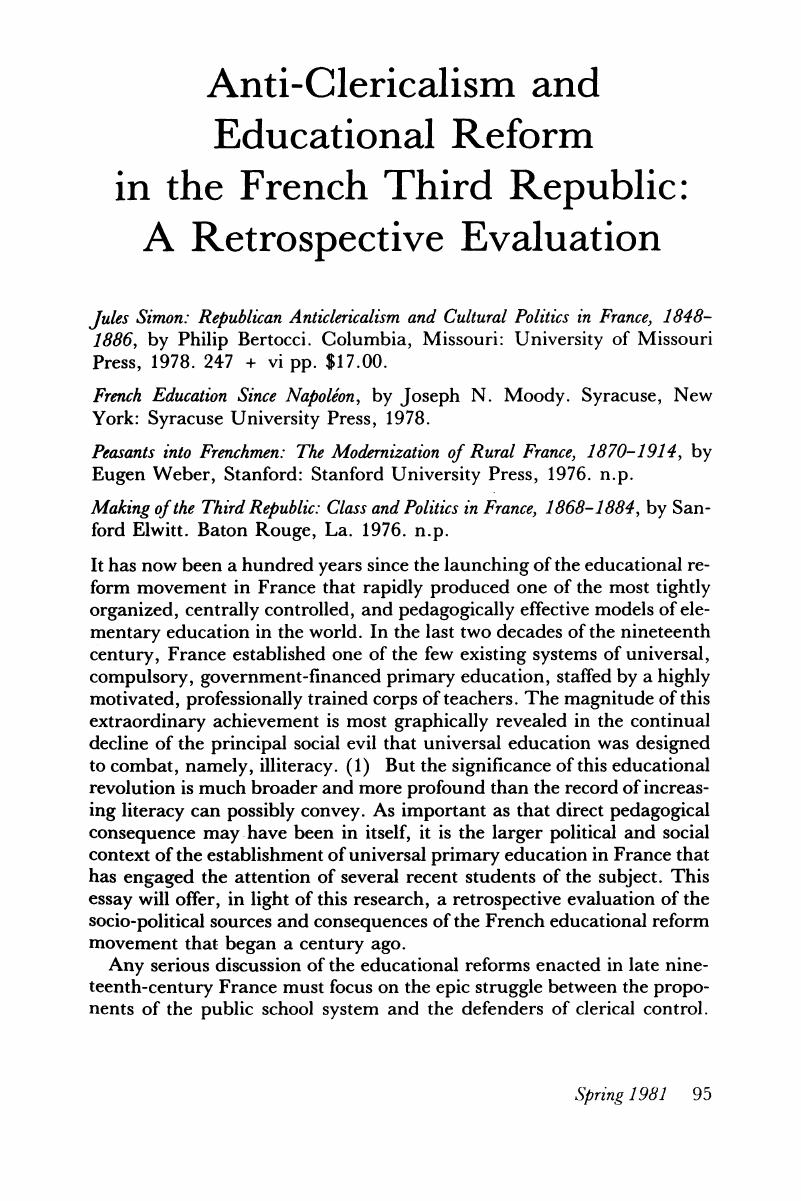Article contents
Anti-Clericalism and Educational Reform in the French Third Republic: A Retrospective Evaluation
Published online by Cambridge University Press: 24 February 2017
Abstract

- Type
- Essay-Reviews
- Information
- Copyright
- Copyright © 1981 by History of Education Society
References
Notes
1. Eugen Weber cautions that literary statistics for this period are so unreliable that they “clearly must be taken with more than a few grains of salt.” However, he marshals impressionistic evidence suggesting that the rate of illiteracy in the central and southern départements probably exceeded fifty per cent in the early years of the Third Republic. Joseph Moody estimates that the illiteracy rate was reduced to approximately four per cent by 1900. See Weber, Eugen, Peasants into Frenchmen: The Modernization of Rural France, 1870–1914 (Stanford, 1976), pp. 309–14; Moody, Joseph, French Education since Napoleon (Syracuse, 1978), p. 97.Google Scholar
2. See, for example, Wright, Gordon, France in Modern Times (Chicago, 1974), p. 235: “The political elite of the time underacted in the social and economic sphere; why did it overact in the religious sphere?” Wright rhetorically asks. “What produced its excessive, almost neurotic emphasis on the clerical problem as the fundamental issue of the age?” Google Scholar
3. See Kindleberger, Charles P., Economic Growth in France and Britain, 1851–1950 (New York, 1964), pp. 39–59, 279ff; Landes, David, The Unbound Prometheus (London, 1972), pp. 209–10.Google Scholar
4. See Kindleberger, , Economic Growth, pp. 108ff, for a summary of this interpretation (though the author himself rejects it); see also Elwitt, Sanford, The Making of the Third Republic: Class and Politics in France, 1868–1884 (Baton Rouge, Louisiana, 1976), pp. 41–44 for an analysis of the sources of this hostility to social reform; Wright, , France in Modern Times, p. 234.Google Scholar
5. McManners, John, Church and State in France, 1870–1914 (London, 1964), pp. 21–22.Google Scholar
6. Ibid., pp. 15–16.Google Scholar
7. Bertocci, Philip, Jules Simon: Republican Anticlericalism and Cultural Politics in France, 1848–1886 (Columbia, Missouri, 1978).Google Scholar
8. Ibid., pp. 161, 166, 195–97.Google Scholar
9. Ibid., pp. 184–85, 192ff.Google Scholar
10. Based on the official definition of “urban” as any locality with 2,000 or more inhabitants, the proportion of rural to urban inhabitants in 1901 still stood at approximately 3 to 2. Weber, , Peasants into Frenchmen, p. 115.Google Scholar
11. See Digeon, Claude, La Crise allemande de la pensée française, 1870–1914, (Paris, 1959).Google Scholar
12. Weber, , Peasants into Frenchmen.Google Scholar
13. Ibid., p. 68, appendix, pp. 498–501.Google Scholar
14. McManners, , Church and State in France, p. 47; Weber, , Peasants into Frenchmen, pp. 331–333.Google Scholar
15. See Keylor, William P., Academy and Community: The Foundation of the French Historical Profession (Cambridge, Mass., 1975), chap. 5.Google Scholar
16. Elwitt, , Making of the Third Republic, chap. 5.Google Scholar
- 1
- Cited by




